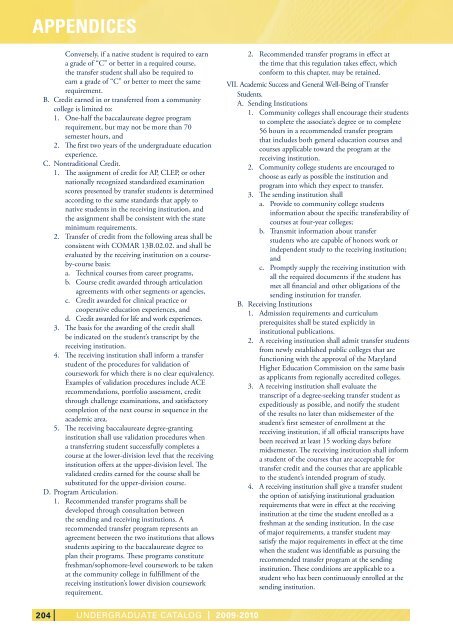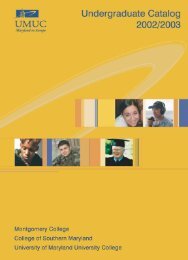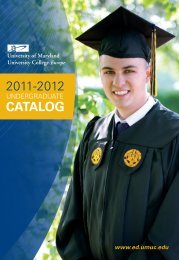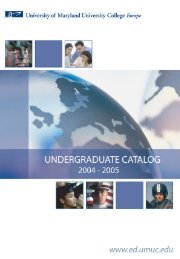UNDERGRADUATE CATALOG - UMUC Europe
UNDERGRADUATE CATALOG - UMUC Europe
UNDERGRADUATE CATALOG - UMUC Europe
Create successful ePaper yourself
Turn your PDF publications into a flip-book with our unique Google optimized e-Paper software.
APPEndiCEs<br />
Conversely, if a native student is required to earn<br />
a grade of “C” or better in a required course,<br />
the transfer student shall also be required to<br />
earn a grade of “C” or better to meet the same<br />
requirement.<br />
B. Credit earned in or transferred from a community<br />
college is limited to:<br />
1. One-half the baccalaureate degree program<br />
requirement, but may not be more than 70<br />
semester hours, and<br />
2. The first two years of the undergraduate education<br />
experience.<br />
C. Nontraditional Credit.<br />
1. The assignment of credit for AP, CLEP, or other<br />
nationally recognized standardized examination<br />
scores presented by transfer students is determined<br />
according to the same standards that apply to<br />
native students in the receiving institution, and<br />
the assignment shall be consistent with the state<br />
minimum requirements.<br />
2. Transfer of credit from the following areas shall be<br />
consistent with COMAR 13B.02.02. and shall be<br />
evaluated by the receiving institution on a courseby-course<br />
basis:<br />
a. Technical courses from career programs,<br />
b. Course credit awarded through articulation<br />
agreements with other segments or agencies,<br />
c. Credit awarded for clinical practice or<br />
cooperative education experiences, and<br />
d. Credit awarded for life and work experiences.<br />
3. The basis for the awarding of the credit shall<br />
be indicated on the student’s transcript by the<br />
receiving institution.<br />
4. The receiving institution shall inform a transfer<br />
student of the procedures for validation of<br />
coursework for which there is no clear equivalency.<br />
Examples of validation procedures include ACE<br />
recommendations, portfolio assessment, credit<br />
through challenge examinations, and satisfactory<br />
completion of the next course in sequence in the<br />
academic area.<br />
5. The receiving baccalaureate degree-granting<br />
institution shall use validation procedures when<br />
a transferring student successfully completes a<br />
course at the lower-division level that the receiving<br />
institution offers at the upper-division level. The<br />
validated credits earned for the course shall be<br />
substituted for the upper-division course.<br />
D. Program Articulation.<br />
1. Recommended transfer programs shall be<br />
developed through consultation between<br />
the sending and receiving institutions. A<br />
recommended transfer program represents an<br />
agreement between the two institutions that allows<br />
students aspiring to the baccalaureate degree to<br />
plan their programs. These programs constitute<br />
freshman/sophomore-level coursework to be taken<br />
at the community college in fulfillment of the<br />
receiving institution’s lower division coursework<br />
requirement.<br />
204<br />
UndERGRAdUATE CATALoG | 2009-2010<br />
2. Recommended transfer programs in effect at<br />
the time that this regulation takes effect, which<br />
conform to this chapter, may be retained.<br />
VII. Academic Success and General Well-Being of Transfer<br />
Students.<br />
A. Sending Institutions<br />
1. Community colleges shall encourage their students<br />
to complete the associate’s degree or to complete<br />
56 hours in a recommended transfer program<br />
that includes both general education courses and<br />
courses applicable toward the program at the<br />
receiving institution.<br />
2. Community college students are encouraged to<br />
choose as early as possible the institution and<br />
program into which they expect to transfer.<br />
3. The sending institution shall<br />
a. Provide to community college students<br />
information about the specific transferability of<br />
courses at four-year colleges;<br />
b. Transmit information about transfer<br />
students who are capable of honors work or<br />
independent study to the receiving institution;<br />
and<br />
c. Promptly supply the receiving institution with<br />
all the required documents if the student has<br />
met all financial and other obligations of the<br />
sending institution for transfer.<br />
B. Receiving Institutions<br />
1. Admission requirements and curriculum<br />
prerequisites shall be stated explicitly in<br />
institutional publications.<br />
2. A receiving institution shall admit transfer students<br />
from newly established public colleges that are<br />
functioning with the approval of the Maryland<br />
Higher Education Commission on the same basis<br />
as applicants from regionally accredited colleges.<br />
3. A receiving institution shall evaluate the<br />
transcript of a degree-seeking transfer student as<br />
expeditiously as possible, and notify the student<br />
of the results no later than midsemester of the<br />
student’s first semester of enrollment at the<br />
receiving institution, if all official transcripts have<br />
been received at least 15 working days before<br />
midsemester. The receiving institution shall inform<br />
a student of the courses that are acceptable for<br />
transfer credit and the courses that are applicable<br />
to the student’s intended program of study.<br />
4. A receiving institution shall give a transfer student<br />
the option of satisfying institutional graduation<br />
requirements that were in effect at the receiving<br />
institution at the time the student enrolled as a<br />
freshman at the sending institution. In the case<br />
of major requirements, a transfer student may<br />
satisfy the major requirements in effect at the time<br />
when the student was identifiable as pursuing the<br />
recommended transfer program at the sending<br />
institution. These conditions are applicable to a<br />
student who has been continuously enrolled at the<br />
sending institution.






